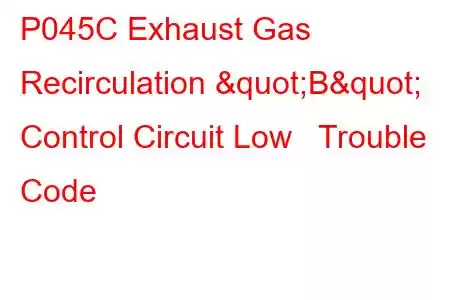P045C Exhaust Gas Recirculation B Control Circuit Low
OBD-II Trouble Code Technical Description
Exhaust Gas Recirculation "B" Control Circuit Low
What does that mean?
This diagnostic trouble code (DTC) is a generic powertrain code, which means that it applies to OBD-II equipped vehicles with an Exhaust Gas Recirculation system. Vehicle brands may include (but are not limited to) Land Rover, GMC, Chevrolet, Dodge, Chrysler, Ford, Toyota, Honda, etc. Although generic, the specific repair steps may vary depending on make/model.
These engine trouble codes refer to a failure in the EGR (exhaust gas recirculation) system. To be more specific - the electrical aspect. The EGR is an integral part of the vehicles emission system whose function is to prevent the formation of harmful Nox (oxides of nitrogen) from forming in the cylinders.
The EGR is operated by the engine management computer. The computer opens or closes the EGR as load, speed and temperature dictate in order to maintain the proper cylinder head temperature. There are two wires to the electrical solenoid on the EGR with which the computer activates it. A potentiometer is also located in the EGR solenoid that signals the position of the EGRs pintle (operating mechanism that opens and closes the passage.)
This works much like dimming your lights in the home. As the switch is turned the lights get brighter as you increase the voltage. Your engine computer fails to see any voltage change as it attempts to open or close the EGR indicating it is stuck in one position. Codes P045C EGR control circuit "B" means no low voltage change to indicate the EGR is opening or closing. P045D is basically identical but it means circuit high as opposed to low. Refer to a vehicle specific repair manual to determine which is the "B" EGR circuit in your particular case.
Unleaded fuel is prone to producing Nox when under extreme temperatures in the engine's cylinders. The EGR routes a regulated amount of exhaust gas back into the intake manifold. The purpose is to dilute the incoming fuel mixture sufficiently to reduce the cylinder head temperature below that at which Nox forms.
EGR operation is essential for more reasons than preventing Nox emissions - it allows more advanced timing for more power without detonation, and a leaner fuel mixture for better fuel economy.
Symptoms
Symptoms will vary depending on the position of the pintle in the EGR at the time of failure.
Extremely rough running engine Check engine light illuminated Drop in fuel economy Decrease in power No start or very difficult to start followed by rough idlePotential Causes
The causes for this DTC may include:
Short to ground Short to battery voltage Bad connector with pushed out pins Corrosion in connector Fouled EGR pintle Failed EGR solenoid Bad EGR Faulty ECU or computerRepair Procedures
If your vehicle has under 100,000 miles, it is advisable to read your warranty. Most vehicles have either an 80 or 100,000 mile warranty on emission controls. Secondly, go online and check for any relevant TSBs (technical service bulletins) related to these codes and their repair.
To accomplish these diagnostic procedures the following tools will be needed:
Volt/Ohmmeter EGR wiring schematic Jumper wire Two paper clips or sewing needlesOpen the hood and start the engine. If the engine has a rough idle, pull the plug on the EGR. If the engine smooths out the pintle is stuck in the EGR. Shut the engine off and replace the EGR.
Look at the wire connector on the "B" EGR. There are 5 wires, the two outside wires supply battery voltage and the ground. The center three wires are the potentiometer used to signal the computer as to the amount of EGR flow. The center terminal is the 5-volt reference terminal.
Inspect the connector thoroughly
Read: 42


